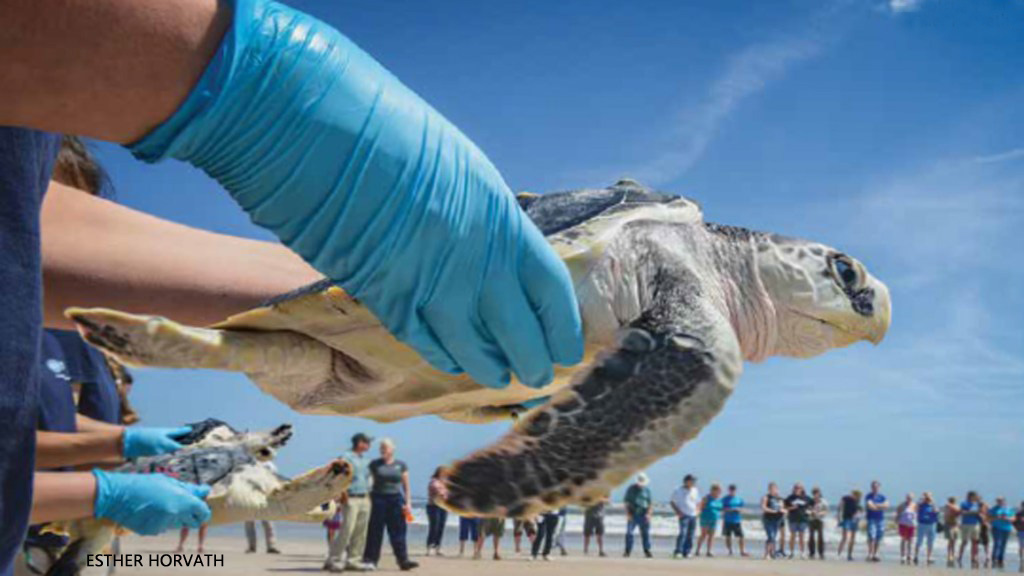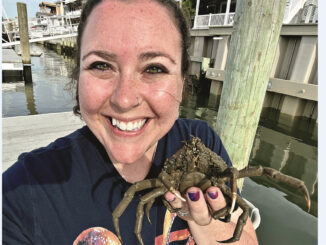
Sea Turtle 911
By Kathy Kranking; photos by Esther HorvathPeople are coming to the rescue of stranded sea turtles.

The bitter, windy winter might seem like a strange time to search for shells on the beach. But it’s exactly the right time if those shells are turtle shells.
This is the season when helpless sea turtles wash up on northern beaches, too cold to move. Most of them are Kemp’s ridley turtles, the most endangered sea turtles in the world. But there are also green turtles and loggerhead turtles. They all need help—and fast!
Read on to see how people are working to bring stranded sea turtles in from the cold.

No Way Out
How do sea turtles—which are warm-water creatures—end up in cold northern waters? Here’s what happens:
During summer, as the ocean becomes warmer, young sea turtles head north along the coast. They’re in search of crabs, algae (AL-jee), and other foods to eat. Many end up in Cape Cod Bay (see map). As winter approaches, it’s time for the turtles to head south again. But the curved “arm” of Cape Cod causes a problem. It acts as a barrier that traps many turtles, keeping them from finding their way out of the bay.
The Big Chill
Most turtles can’t make their own body heat. Their bodies stay about the same temperature as their surroundings. So as the water temperatures drop lower and lower, the turtles become “cold stunned.” They lose muscle control and can’t move. Unable to swim or eat, they float helplessly at the mercy of the wind, waves, and tides. Eventually, they’re washed ashore.
A Growing Problem
Each year, hundreds of turtles wash up onto Cape Cod beaches. And the numbers have been increasing. Scientists aren’t sure why. But they think climate change may be part of the problem. As northern waters get warmer, turtles go farther north in summer than they used to. Then, when the water turns cold, it’s too late for them to swim back to warmer water. And once the turtles wash ashore, they face air temperatures even colder than the water. By then, minutes count. If the turtles don’t get help, they’ll die.
To the Rescue!
That’s where people on a rescue mission come in. They’re volunteers and staff of Mass Audubon’s Wellfleet Bay Wildlife Sanctuary on Cape Cod. Twice every day during the winter months, these people bundle up and walk the beaches of Cape Cod looking for cold-stunned turtles. When they find one, they move it away from the water and cover it with seaweed or beach grass to protect it from the wind. Then they mark the area so it can be found by rescue staff.
Next, they call the sea turtle rescue team at the Wellfleet sanctuary, and more people race to the beach. These staff members find the markers showing where sea turtles are. Then they load the turtles into cars to take them to the sanctuary.

Turtle ER
At Wellfleet, workers examine the cold-stunned turtles carefully. They weigh them, measure them, photograph them, and check for wounds. Then they tuck them into boxes lined with towels and send them to an animal care center run by the New England Aquarium.
The animal care center looks like an emergency room at a hospital for people. There are examination tables, microscopes, computers, and medical equipment. But unlike an emergency room for people, this one also has tanks of water.
The Road to Recovery
Animal doctors at the care center act quickly. They give the turtles blood tests, which show that most of them are starving and dehydrated. They’ll need to be given fluids and medicine for days or even months. Many need to be treated for pneumonia (noo-MOHN-yuh), infections, or other problems.
Doctors also take the rescued turtles’ temperatures. The normal temperature for a sea turtle is around 70°F. But after floating in the icy water, these turtles often have temperatures that are 20°–25° below normal.
The turtles need to be warmed up to recover. But the warming has to be gradual, or it would be too much of a shock to their bodies. So they’re placed in special containers where the temperature inside is raised slowly—just 5° per day. The turtles also get some “physical therapy.” They are put in tanks of water for a short time each day so they get a chance to slowly build up their swimming muscles. As they get better, they spend more time swimming around in the water.
Home Again
Depending on how sick a turtle is, it can take several weeks or even months to get all better. But when the turtles are ready, they’re taken to places where the ocean is a “just right” 70°F. Then they’re released into the water. And thanks to the hard work of so many people who care, the turtles paddle off for a second chance at life.
Rangers: The turtles in this story were stranded along Cape Cod. But each winter, cold-stunned turtles are stranded in other places along U.S. coasts, too. This happens during “cold snaps,” when temperatures drop suddenly. Many groups work hard to help those turtles, as well.
















